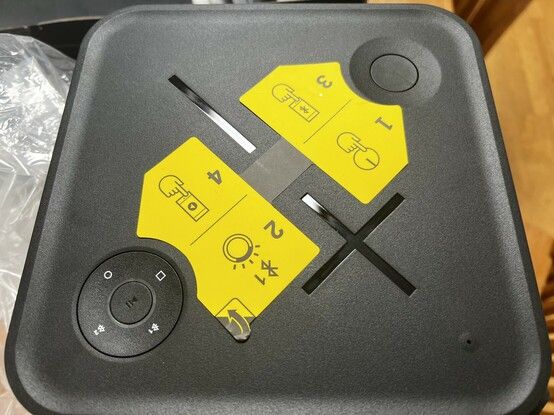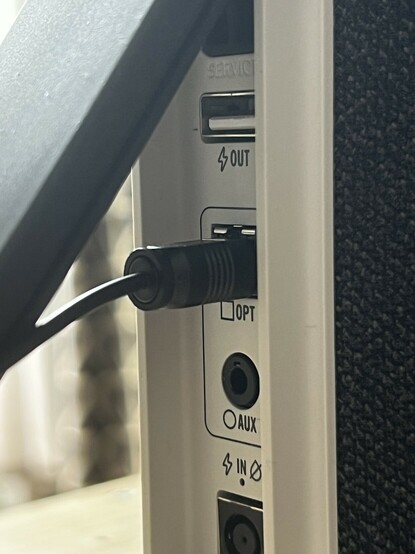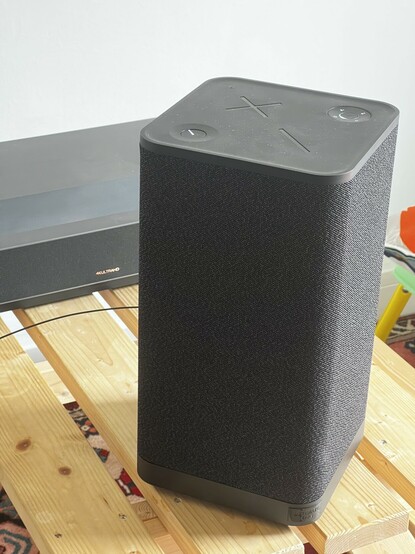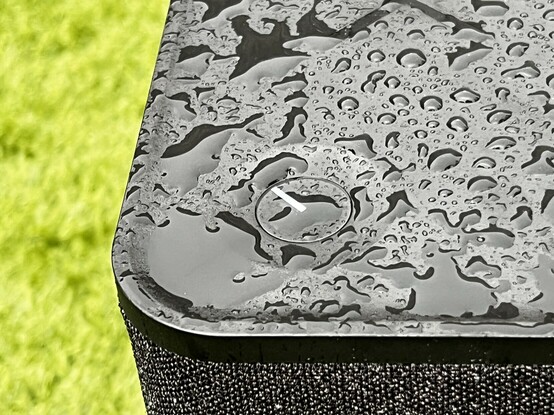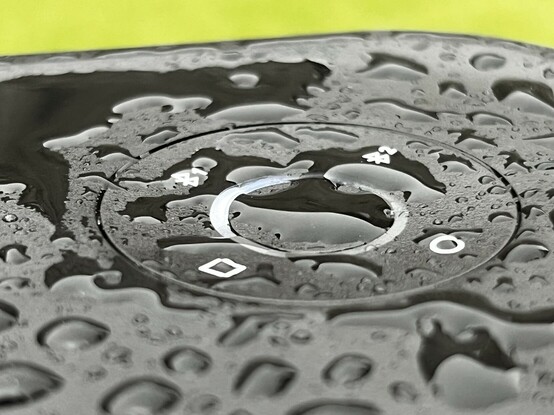Ultimate Ears HYPERBOOM Review
HYPERBOOM isn’t a product that’s willing to compromise. Ultimate Ears don’t care if you want to listen to classic FM in the kitchen. In fact, what are you even doing indoors? Get outside and party!
I suppose the name should have clued me in. Ultimate Ears are not hiding the fact this speaker exists for one reason and one reason only: to make your neighbours file a noise complaint. That’s not to say there’s anything wrong with sticking to a premise. HYPERBOOM might be big, bulky and awkward around the home, but when it comes to raucous garden parties it’s the undisputed star of the show.
HYPERBOOM is a chunky monolith of a speaker, standing 36cm tall and having a square footprint that allows speakers to fire in three directions with the bass-port in the remaining direction. Most of the surface is fabric covering, hiding all of the speakers, with the top and bottom being plastic. On top are the controls. The volume up and down buttons are huge, and clearly marked with large + and – symbols that are slightly indented and easy to find by feel. The on/off button sits in one corner of the top, and a set of buttons on the opposite corner provide fast switching between Bluetooth devices and auxiliary/optical inputs. These buttons aren’t distinct by feel, but occupy the cardinal directions around the circumference of an inner, multi-function music control button. Some little plastic bumps – one on the first Bluetooth device, and two on the second – might have made it easier to find these by feel.
Down one corner of the speaker is a rubber handle that sits flush, but can be pulled out to carry HYPERBOOM around. It’s quite an elegant design, despite being quite – I suppose – brutalist with its thick, squared off profile. Below the handle is a rubber gasket covering the auxiliary inputs- you get USB Type-A, TOSLINK and a 3.5mm audio input, in addition to a barrel jack power supply.
This is an odd selection of ports, TOSLINK is almost redundant (we’ll get to that later), USB A is practically obsolete, and a barrel jack power supply is an odd choice when USB Type-C could have done the trick without adding yet another single-use power supply to the grand tower of e-waste we’re building to the heavens.
But on the plus side, a dedicated, “dumb” power supply is always going to work without any fuss or hassle, and always going to charge your speaker at the same rate. In this case it’s a monster 90W. Just don’t misplace it. You’ll also sadly not be able to charge up the HYPERBOOM from a portable battery. I’d feel a lot more ingratiated toward the dumb, dedicated power supply if I could use the HYPERBOOM while charging, but when I first received the speaker and tried to turn it on, it just said “Charging, please wait” and abruptly turned off. Grumble! It’s a little less obnoxious when the battery is full, at least.
While we’re on the topic of power- the HYPERBOOM has a 14.4v 3060mAh / 45Wh battery, judging by FCC photos and by iFixit’s replacement pack. This is roughly the same capacity as the Soundcore Motion X600s 46Wh 7.2v battery, which is quite surprising for a speaker that’s roughly four times the size. Nonetheless HYPERBOOM’s claimed battery life is long enough that it doesn’t strictly need a bigger battery, but it still feels like a missed opportunity for this speaker to excel.
A 3.5mm jack is also an odd choice on a splashproof speaker. I can’t really fault the HYPERBOOM for having one, and I’m pretty sure they still come basically free with most Bluetooth audio chips, but who’s using these anymore? I’d challenge most non-technical people to even find a 3.5mm cable, much less have a device they’d want to sit outdoors wired to a splashproof speaker. Indoors is a different story, you could connect to the 3.5mm output jack of your smart home speaker (assuming you’ve got one that even has an output jack) and turn the HYPERBOOM into a WiFi speaker.
I mostly took this photo so I could remember where the stickers go when I send it back. But a high contrast, quick-start right where it counts is a nice touch.
The big volume control buttons are super easy to use, but feel like a waste of the top of the HYPERBOOM. There was ample room to put splashproof wireless charging in the top here, instead of the USB port which can’t reasonably be used outdoors without compromising the speaker’s ingress protection. It looks like the huge plus and minus are sort of a running theme across the product range, though, so it’s at least consistent. Unfortunately these huge buttons are also incredibly accessible to children, which is both a blessing and a curse. If the HYPERBOOM volume didn’t go up to “blow the party wall between us and our neighbours to rubble” I’d be less concerned.
When it comes to sound, really the point of the HYPERBOOM, it absolutely delivers on the promise implied by the product name. It’s big, boomy and louder than you’d ever reasonably get away with if you don’t have a detached house. It doesn’t boast much in the way of fancy spatial audio, but does have an onboard microphone that tunes the output to the environment. It’s really hard to make any kind of objective evaluation of what this does to the audio, but I think I’ll suffice to say that you won’t be disappointed. It seems a lot of HYPERBOOM customers grab two and use them indoors almost as bookshelf speakers. I weep for their neighbours!
Rigorous adherence to its niche, both in design and features, means the HYPERBOOM doesn’t have as much to offer when it’s off the party clock. But Ultimate Ears have made a curious accommodation for this: the aforementioned TOSLINK (or Optical) input. For those of you untrained in the myriad ways you can connect one doohickey to another, TOSLINK (short for Toshiba Link) is a fibre-optic audio connection standard you’ll find most often used to connect sound bars to TVs. Does that mean HYPERBOOM is a TV sound bar? Well, sort-of. While you can jack-in to add some punch to a movie night, the lack of a remote control means it’s a little awkward to use on a regular basis. Do I need to be the one to venture that… uh… well most smart TVs these days will happily pair to a Bluetooth speaker?
HYPERBOOM connected via TOSLINK ( yes a Bluetooth speaker with an optical connection! ) to the Wemax Nova laser projector. The Nova has its own speakers. But the HYPERBOOM punches a little harder.
That said, there’s always projectors. Even the best projector speakers don’t hold a candle to the HYPERBOOM and connecting it up to my Wemax Nova short-throw projector to add some punch to the sound was certainly both effortless and satisfying. Of course I could just as easily have paired it via Bluetooth, but TOSLINK at least is latency free. I watched Guardians of the Galaxy 3 with this setup, and had to -uh – ride the volume a little out of fear that next-door would come knocking and ask why I’m listening to 10 second snippets of pop music while detonating fireworks in my living room.
Overall the HYPERBOOM is an odd duck. It’s a merciless beast of a speaker, but seems to be anchored to legacy ports that a device with this niche appeal, and this price, could have easily cast aside in favour of a slick, modern approach. There’s no need to be all things to all people. In addition to these strange accommodations for antique devices, the HYPERBOOM represents a downgrade in ingress protection versus its contemporaries. The MEGABOOM 3, BOOM 3 and WONDERBOOM 3 all boast IP67 offering some submersion protection versus the HYPERBOOM’s very modest IPX4- no dust protection and only resistance to mild splashes. This is a little ironic, since the HYPERBOOM can be paired with these smaller speakers to create a multipoint system in which it’ll be the weakest link.
Devices don’t absolutely need to have full submersion ratings, but they certainly offer more peace of mind should a rowdy party goer- for example- accidentally knock it into the pool or hot tub. With UE’s MEGABOOM marketing including an underwater pool shot, you’d think that would be right at the top of their list to replicate with the big, boomy style of HYPERBOOM.
It was a moderate day so we sat outside and had some music on as the clouds gathered and threatened to unleash hell.
And then it rained. Quite hard. And I let the HYPERBOOM continue playing Justice as water splashed off the top.
Definitely splash proof!
If you party often, or just want an absolutely no-punches-pulled monster of a Bluetooth speaker then HYPERBOOM is that monster. It’s bulky and ridiculously overkill for casual, indoor listening, though, so you’re going to need a full party schedule to get your money’s worth. If you’re looking for something that’s a little more suitable for use around the home, I’d suggest the Soundcore Motion X600.
Now, give me a HYPERBOOM 2 with a bigger battery, better ingress rating and nothing but a waterproof USB Type-C port (for charging and… charging) on the back and a wireless charger on top and we’ll talk! … wait, do wireless chargers work well when they’re wet?
